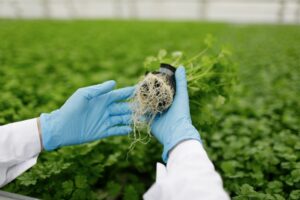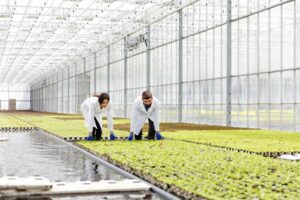When was the last time you opted for soil testing services? It is crucial to utilize soil testing services to obtain an accurate understanding of the health and quality of the soil, not just on your own, but from a trusted crop adviser and experienced lab experts. Yes, you can do the soil tests at home, but these tests will only show a part of the picture. It is crucial to see the full picture of the soil’s health and quality. As a grower, you need to know the soil’s pH levels, chemical composition, soil structure, and biological makeup at a microscopic level. The information can influence the fertilizer recommendation based on the soil test. When you put the soil testing service results to work, it helps you to apply the regenerative practices to improve the soil health and quality. If you have any queries on soil tests, let us share why soil testing services are not only worth the investment but crucial to growing a healthy, sustainable crop.
Are Soil Testing Services Worth It?
Soil testing services are worth the investment, especially if you want to make an informed decision based on your soil’s health for a successful spring planting. Soil tests can offer the growers the information they need to enhance the soil’s quality and health.

The primary benefits of soil testing and fertilizer recommendations include:
1. Reduced runoff instances
2. Better nutritional balance
3. Optimized crop yield potential
4. Optimized fertilizer inputs
5. Soil conditions won’t change drastically
What Problems Can Soil Testing Services Identify?
Soil tests can identify excess levels of nutrients, high pH levels, salts, low organic matter, or drainage issues. If the problem is being diagnosed, a grower must take soil samples from the normal and abnormal areas to make a comparison. The process of taking action after the soil test results can take a few days of planning. Collecting soil samples, sending it off, receiving and interpreting the results, and purchasing the fertilizers. You can plan accordingly to get the results and products before acting on the recommendations based on the soil test.
Pairing Regenerative Agriculture Practices with Soil Testing Services to Enhance Spring Planting
Once you get the soil test results, it is time to start the regenerative practices to enhance soil health. There are numerous benefits of regenerative agricultural practices that support soil health and enhance crop production. By investing in cover crops, no-till or low-till practices, and feeding the soil microbes, you can support the soil health. It is better to improve your soil health with day-to-day food production practices, when possible, to enhance the yield. Here are a few things to consider to enhance your spring planting.

Invest in a Winter Cover Crop
Sometimes, the soil testing and fertilizer recommendations might not indicate you need a winter cover crop, but investing in a cover crop is always a good idea. Cover crops help prevent water and wind erosion. A root system in the field will hold onto the soil. The root systems of winter cover crops will also help in reducing soil compaction and increase soil aggregation. A cover crop is also a great way to store carbon in the soil. It improves nutrient availability and supports soil life. It can help with your fertilizer application, and the soil microbes are going to thank you for the extra biomass. When it is time to plant, you can mow down the cover crop. Not only is the post-harvest residue a great mulch, but it also helps with weed prevention as well.
Practice No-Till or Low-Till System
The post-harvest residue can have an impact on the spring planting. Starting from popped tires to clogged machines, tillage became a crucial practice to deal with residue. There are some growers that consider burning or tilling the fields, but these are not the best regenerative options to deal with post-harvest residue. Burning fields can destroy microbes, and excessive tillage causes soil compaction and breaks up soil microbial communities.
Compaction creates root impediments and nutrient loss. It also creates impenetrable layers that separate the biological life from the nutrients. The nutrient loss, impenetrable layers, and root impediment are not healthy for your crops, your bottom line, or your ROI. There is a better way to manage the post-harvest residue. It is practicing a no-till or low-till system to avoid compaction. To do this, you must consider every single pass you need to make with heavy equipment through the field. Think about where to cut back on the passes to protect the soil.
Soils that are undisturbed and have more continuous living roots will start to show improvements in their structure because organic residue from plants and microbes glue the mineral particles together in creating aggregates. It is better to avoid planting in the wet conditions to avoid compaction. It is always better to wait till the fields are dry to protect the soil structure and texture.
Feeding the Soil Microbes
Within the soil is a mix of bacteria and fungi, also known as soil microbes. Well-fed soil microbes can help in making the most of the fertilizer, improve nutrient utilization, and create aggregates for improving soil structure. Many growers don’t reap any of these benefits because most of the soil microbes in the farm soils are dormant because of starvation. There are two ways to activate the dormant microbes:
1. Adding organic matter to the soil.
2. Invest in soil microbial food to feed the hungry soil microbes.
Healthy soil equals healthy profits. Therefore, combining the results of soil testing services and regenerative agriculture practices will help growers with spring planting. Start with a soil test and take steps to avoid compaction and support the soil microbes to attain your desired ROI. If you are looking for the best soil testing services, contact SoilOptix® today! Visit https://soiloptix.com/ for details.
